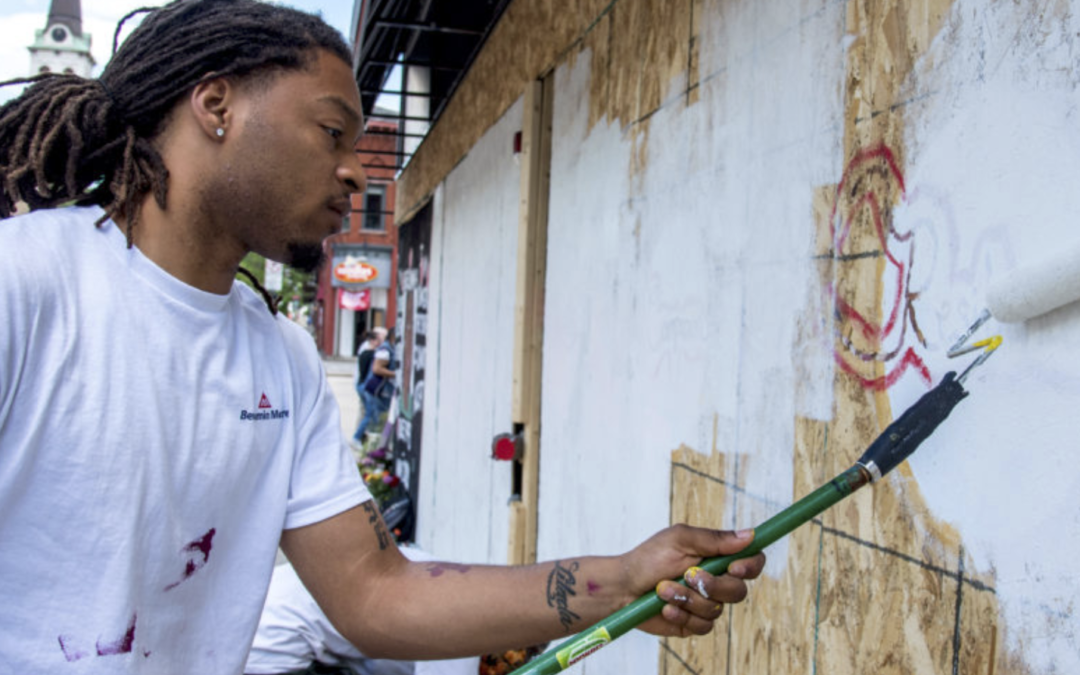
Mural project brought Black voices to a shuttered State Street
This story was produced by Wisconsin Watch, a nonprofit, nonpartisan investigative reporting organization that focuses on government integrity and quality of life issues in Wisconsin.
On May 31, the day after violence first broke out on State Street in Madison during demonstrations in response to the death of George Floyd at the hands of Minneapolis police, a transformation began.
Businesses up and down Madison’s defining corridor shuttered. Plywood sheets covered windows — some preemptively and some to cover windows already smashed by looters.
“It looked kind of dead before the murals,” said Amira Caire, a 22-year-old Madisonian and one of over a hundred artists who lent their time, talent and paint to an effort to decorate the barren spaces with colorful messages of pride, perseverance, anger, justice and unity.

Will Cioci / Wisconsin Watch
Danielle Mielke, 19 (left), and Amira Caire, 22, worked on a mural at the University Bookstore in downtown Madison, Wis., on June 9, 2020. The mural depicts Tony Robinson, a Black teenager who was shot and killed by a member of the Madison Police Department in 2015. Mielke said the mural is a way to shed light on Robinson’s death and show people how community members felt in its aftermath. “We wish we weren’t painting Tony’s face up here.”
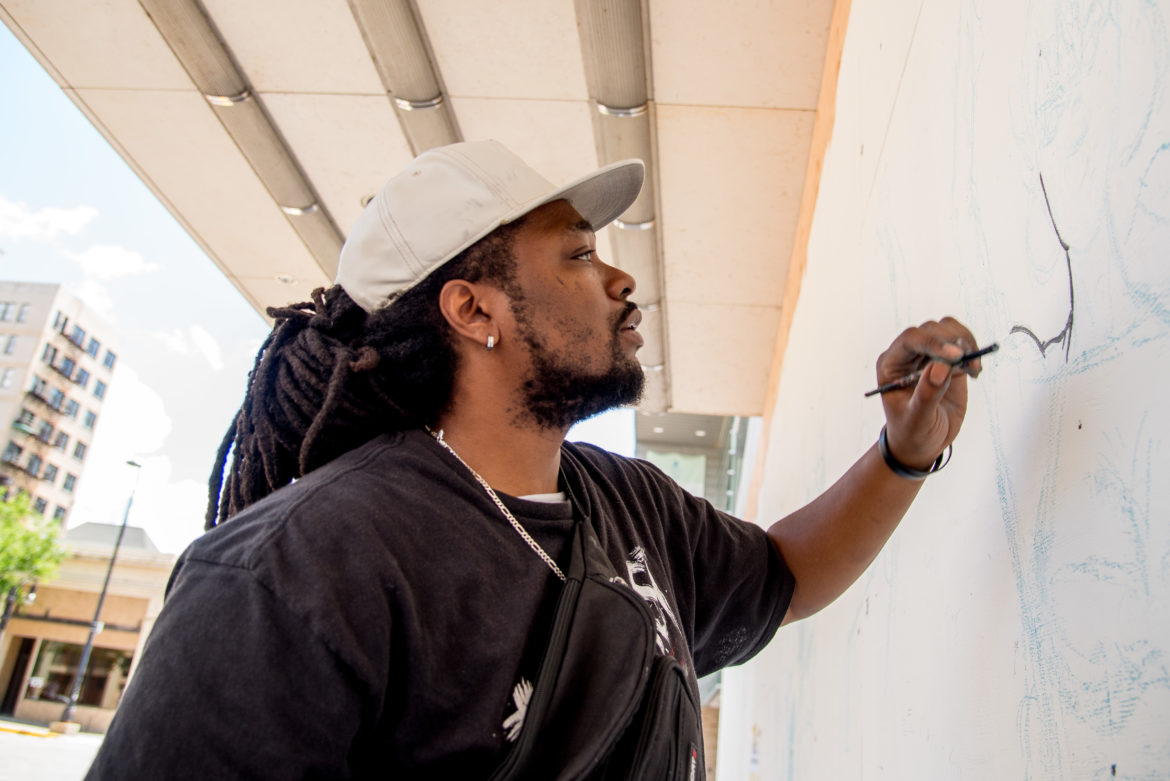
Will Cioci / Wisconsin Watch
Artist Duowan Rimson, 35, of Madison works on his mural outside the Overture Center in downtown Madison, Wis., on June 11, 2020. Rimson said that his goal with the mural was to force white passersby to put themselves in the shoes of the police officer and understand how the police view Black people and Black children. “I’ve been wanting to do a mural since it started,” Rimson said of the recent movement to decorate State Street with public art. “It’s a good way to express not only our talent but our goals and messages. It’s not all about looting and rioting, that’s literally the tip of the surface.” Rimson expressed his frustration with how the mural projects have been carried out in some places. “I see some murals that don’t have anything to do with the cause. That’s exactly what Black people mean about us being overshadowed, about things being taken from us.” Asked about what change he hoped would come from the current movement, Rimson said, “I don’t know what change necessarily would come. But in order to change we need to gain understanding. These murals are helping the people who don’t want to go out and do the research. They’re eye openers . . . We’re not saying let us get away with murder. But we’ve been compliant and done everything, and we still get killed.”

Will Cioci / Wisconsin Watch
Activist Lilada Gee (left) and artist Cassandra Marzette pose in front of their mural-in-progress on the Overture Center on State Street in downtown Madison, Wis. on June 11, 2020. Marzette and Gee were commissioned by the city for a number of murals throughout the downtown area.
The mural project began on May 31, when both the mayor and Common Council president contacted Madison Arts Program Administrator Karin Wolf to request a “rapid response” art program for the shuttered storefronts. Working with her program’s community cultural partners, Wolf reached out to artists who had worked with the city before. In the following days, as more businesses covered their windows, the Arts Program posted an open call for artists interested in participating in the project.
The mural project was funded through another program, Arts in Public Places Looking Forward, which had been established just a few weeks earlier to support artists who have lost income due to the COVID-19 pandemic. The Madison Arts Program also prioritized artists who had been affected by racial violence and injustice, Wolf said.
Over the ensuing two weeks, more than 100 murals were painted as commissions from the city. Many more works of graffiti and other public art appeared in spaces not used by officially commissioned artists. Nearly all of the pieces focused on support for the Black Lives Matter movement or called for an end to police misconduct.
“I feel that the symbolic language of visual culture can reach people,” Wolf said. “We have to reach people on many different levels to help them understand the devastating effect that racism has had on this country.”

Will Cioci / Wisconsin Watch
Mishelle McKnight (second from left) poses with her nephews Ethan (left) and Eton Wesley (right) and her daughter Bada Scates on Lake Street in downtown Madison, Wis., on June 11, 2020. McKnight’s daughter attends O’Keeffe Middle School in Madison, which reserved a space for students to paint murals in the wake of recent protests against police misconduct and racial injustice. McKnight said she wanted to help students actively participate in the current moment, saying that, “the change that we need to see is going to be for our children.” McKnight said that both her son and the father of her children have been subject to violent policing in the past. Asked what change she would like to see, McKnight said, “treat Blacks the same as you do anybody else. Treat people like human beings.”

Will Cioci / Wisconsin Watch
Shiloah Coley, 21, looks at a reference photo of Aiyana Mo’Ney Stanley Jones as she paints a mural outside the Overture Center in downtown Madison, Wis., on June 11, 2020. Stanley was seven years old when she was shot and killed in a police raid in Detroit, Mich., in 2010. Coley used Stanley and the likenesses of other young Black people killed by police as the inspiration for the figures in her murals. Coley, originally from the suburbs of Chicago, is a recent graduate from the University of Wisconsin-Madison, where she studied public art and the criminalization of graffiti and other forms of artistic expression. “I’ve always believed in the arts as a super transformative thing,” she said. “I wanted [this mural] to be two Black teenagers with a confrontational gaze. People need to reckon with Black people in this space and taking up space in Madison.”
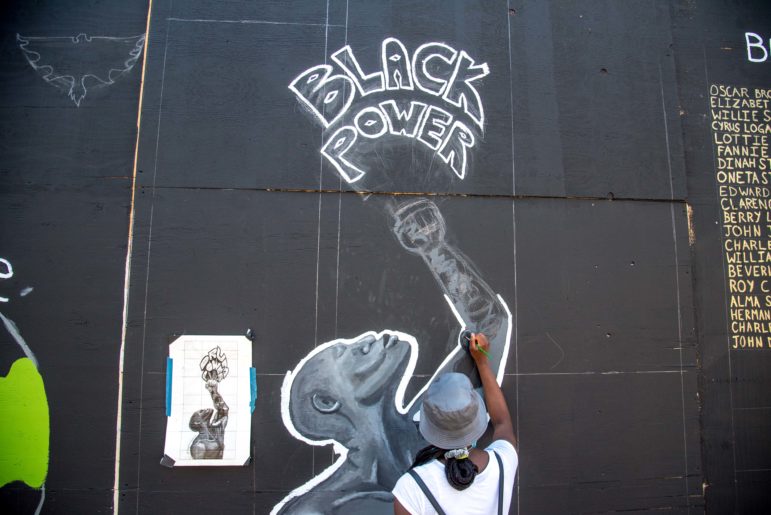
Will Cioci / Wisconsin Watch
Yani Thoronka, a sophomore at Madison East High School, works on a mural outside the Overture Center in downtown Madison, Wis., on June 11, 2020. The mural was designed by the Madison-based youth leadership organization Drum Power, of which Thoronka is a member. “Everything that’s happening takes a really big mental and physical toll on you,” Thoronka said. “We want to empower Black people during this time.”
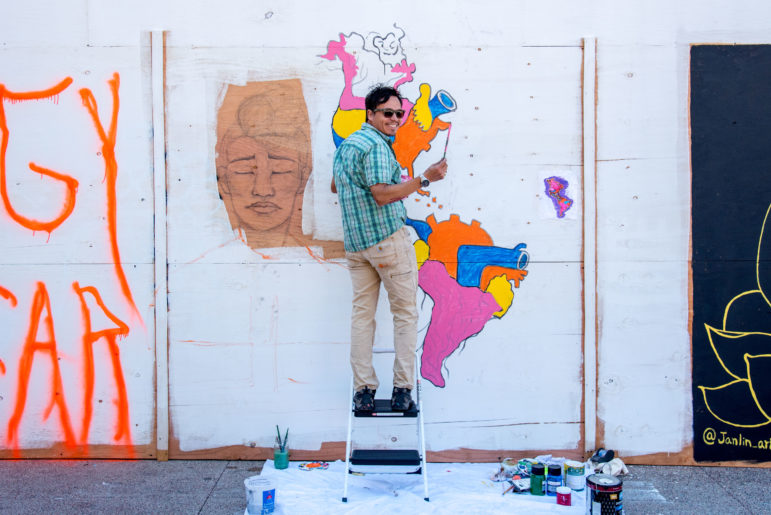
Will Cioci / Wisconsin Watch
Richie Morales, 39, paints a mural on the Overture Center on State Street in downtown Madison, Wis., on June 11, 2020. Morales, born in Guatemala, has lived in Madison for two years. “America is a great continent,” Morales said. “But it needs to create a balance of power, of money, of natural resources. I want to unify America.” Morales also spoke about the value of art during social movements. “I think art can change lives. Art is essential. Sadly, sometimes art stays outside of the light because there aren’t a lot of profits in it.”
Wolf said the city officially ended the mural project on June 14. State Street businesses have since begun to unboard, taking down the murals from their windows and doors.
It is not yet clear what will happen to the artwork after it is removed. The decision lies with individual businesses and property owners about when to reopen their storefronts. Wolf said that Madison’s Central Business Improvement District, which works to coordinate and support many downtown businesses, was keeping some of the murals in storage while a plan is formulated. The city is currently collecting input through an online poll and conversations with artists to decide how to move forward. Options being considered include temporary exhibitions, auctions, or donating the works.
“I can’t speak for everyone else’s work, but I do hope they aren’t simply archived and forgotten,” said Simone Lawrence, a local artist whose portraits of Malcolm X and Colin Kaepernick have recently been taken down from the Driftless Studio windows near the top of State Street. “I’d like to see an exhibition. Even more ideally, I’d like to see them sold and the proceeds go to Black-owned organizations and/or directly to the artist.”
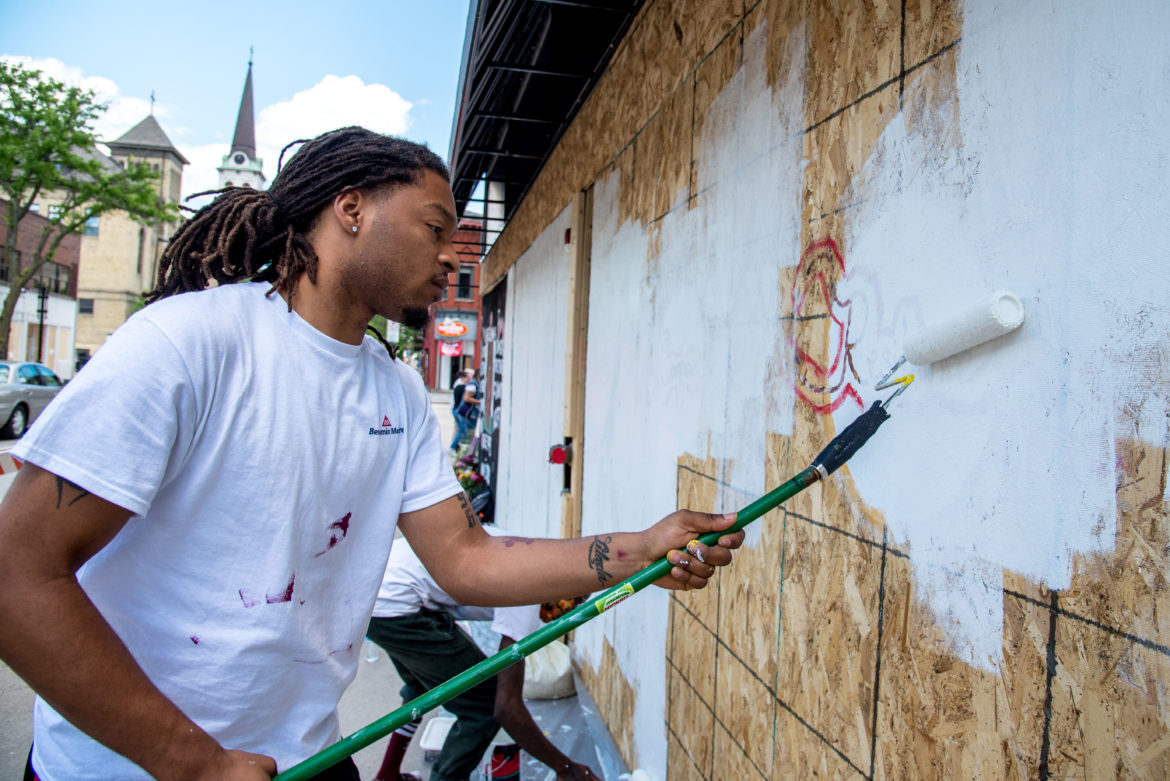
Will Cioci / Wisconsin Watch
Chris Lewis, 23, paints over a mural on Shortstack Eatery in downtown Madison, Wis., on June 11, 2020. Lewis said that the city government, which commissioned many of the murals, wanted to replace the existing piece with a more ambitious one. “I’m covering up this shit,” Lewis said. “The city wanted us to. They wanted something bigger, something excellent.” Lewis, who has worked with his mother, local activist Lilada Gee, and a small group of community members to paint a number of murals on State Street, said that the public art projects were exciting to be a part of. “It’s been really eye opening. It feels good to get out here and be among the people, it’s a whole art community. I’m not even really an artist, but it’s been a fun experience.” But Lewis also worried about whether the murals reflected a deeper shift in tone and thinking about issues surrounding Black lives and police brutality. “I think it’s something that’s pretty to look at. They turned something bad into something good. Which kind of pisses me off. I think in part they’re covering it — you’ve put a bandaid over a wound. For some people it’s genuine, but for most, nah. Some businesses feel like they have to let it happen because other people are out here doing it.”

Will Cioci / Wisconsin Watch
Owen Gwynne, 54, of Madison paints a mural recreating a work by DarRen Morris, a Wisconsin man sentenced to life in prison at 17 in 1995. Gwynne was invited to help paint the mural by Phil Salamone and Judy Adrian, Madison natives who Morris has developed relationships with from prison. Salamone and Adrian wanted to include Morris’ art on State Street to broaden the conversation around policing to cover the entire criminal justice system. The mural is a recreation of a work by the artist DarRen Morris, who was sentenced to life in prison in 1995. Adrian, who helped Morris to write his book “In Warm Blood,” introduced Morris to Salamone, a Madison-based artist who organized the mural as a way to broaded the ongoing conversation about policing to the entire criminal justice system. “I wanted to contribute, but I didn’t want it to be about me. DarRen represents something that people arent talking about. There are higher arrest rates, longer sentences, higher recitivism for African Americans,” Salamone said. “Paint is the strongest voice I got.”

Will Cioci / Wisconsin Watch
Shahaney Williams (left), 14, and Yasmine Clendening, 12, paint a mural on Lake Street in downtown Madison, Wis., on June 11, 2020. Both Williams and Clendening are students at O’Keeffe Middle School in Madison, and painted on space reserved for them and their classmates by O’Keefe art teacher Kati Walsh. “I thought it was important to show that some people actually care,” Williams said, speaking of the murals as an alternative to participating in the protests for young people. “Some people want to participate but they’re too afraid to walk with [protesters], because of the tear gas and rubber bullets.”
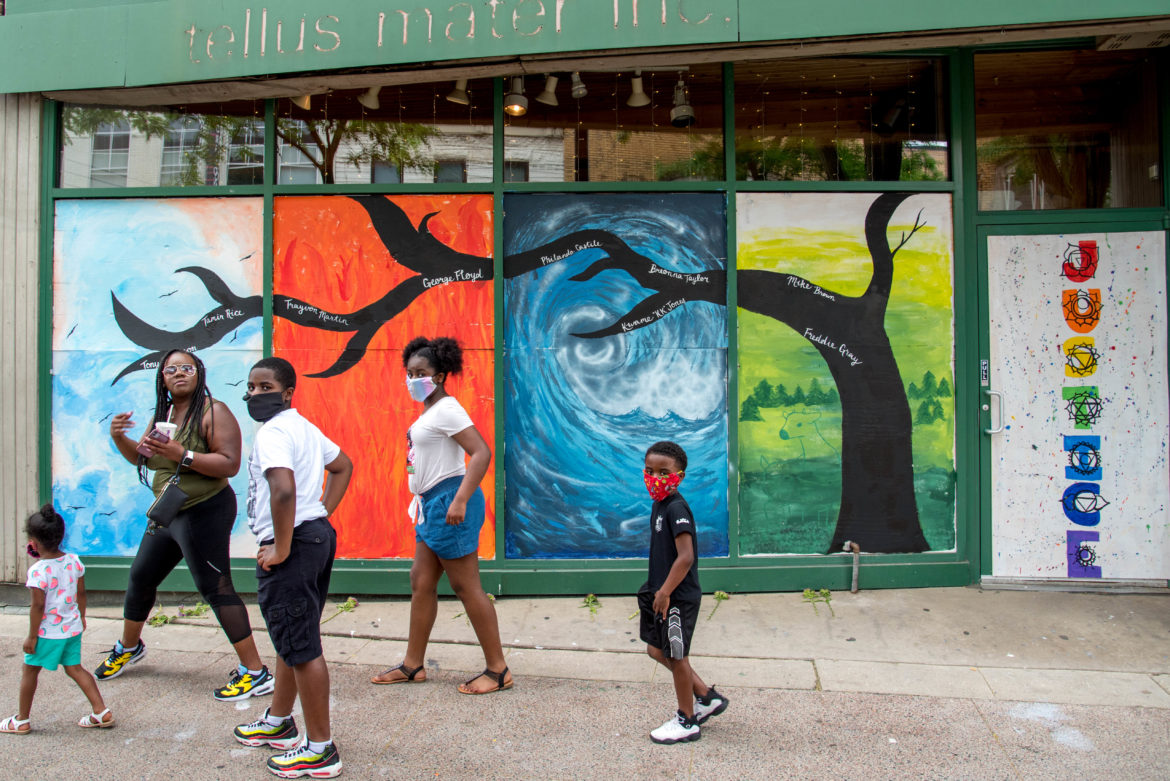
Will Cioci / Wisconsin Watch
Arielle Edmonds (second from right), 31, walked up State Street in Madison, Wis., with her four children to look at the murals on June 9, 2020. “I wanted to show my kids what’s going on so they can be aware of what’s going on in their community.”
